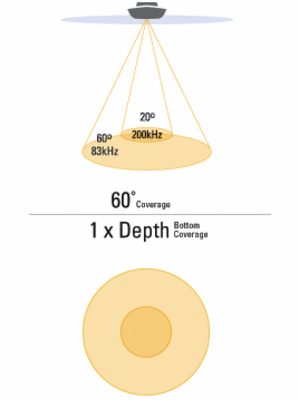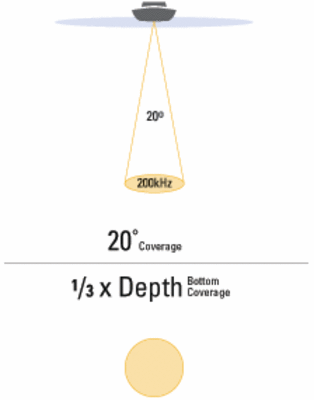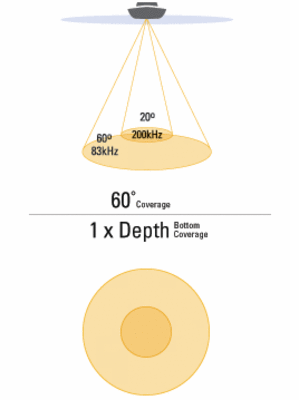I’ve just installed a new sonar and plan to get out this weekend. I am wondering which setting you prefer to run your transducer on 83khz or 200khz. I’m guessing 83khz for shallower (20′ or less) and 200khz for deeper water.
Posts: 6
IDO » Forums » Fishing Forums » Toys for Big Boys » Outdoor Gear Forum » Humminbird 83khz vs 200khz transducer?
I’ve just installed a new sonar and plan to get out this weekend. I am wondering which setting you prefer to run your transducer on 83khz or 200khz. I’m guessing 83khz for shallower (20′ or less) and 200khz for deeper water.
Nick, that’s actually not correct.
200 kHz has a narrower cone than does 83 kHz.
With a 60 degree cone, the 83 kHz is used for downrigger applications. It can be used to mark the cannonballs that would be outside of the narrower, 200 kHz cone.

Sptitz, the most common application is to run both frequencies at the same time.
Depending on which ‘Bird model you’re running, you may have the ability to see the returns from each of the frequencies independently of each other. Check out the 200/83 split sonar view to see what each frequency is seeing.
Again, depending on your model, you may be able to use the beam select feature (200, 83, or 200 + 83). This would be found under the sonar menu tab.
If it were me, for general use, I’d be running the 200 + 83 combo.
Please give me the math used to determine how big of an area on the bottom is based on depth with the 200 + 83 combo setting. I prefer to use one or the other, then I know exactly where the object should be when making a sonar pass. Cone size is critical to understand based on depth if targeting small areas of interest. I run 200 all the time usually in a split mode with either navionics map or side image now. Should be able to get even better accuracy with bottom contours running that 455 and 800 side imaging ducer.
Tight Lines.
With 200 kHz, the bottom coverage is ~ 1/3 of the water depth.
With 83 kHz, the bottom coverage is ~ equal to the water depth.
These images are from the Humminbird website.


Does anyone run a bird and lowrance side by side? I am curious about what kind of interference I might get if both ducers are mounted in the same location.
Two transducers operating at the same frequency, no matter who manufactured them, will interfere with each other. The interference is reduced by moving the transducers apart from each other…one on the transom and one on the bowmount is a common application.
Great explanation Jason I usually run both 83 and 200 together. All so if I need to find a particular spot or vertical jigging then I will switch up to 200 or turn on the SI and lay a way point down on the spot. Gotta luv SI 

Something not mentioned on the monochrome models when you have the unit in 83/200 with the fish ID turned on the fish in the 20 degree beam will be solid black and the fish in the 60 degree portion of the bean will be hallow. On the color units with the same settings the fish in the 20 beam will be green and the fish outside will be blue. Normally in shallow water I turn the 20 beam off and the gain for the 83 HZ down to 3-4 or even lower depending on the water clarity I may go even lower. When you get into water that is less than 6 feet you may get too much surface clutter if it is too high. There is also a surface clutter adjustment but I would rather leave it alone and just adjust the gain (sensitivity)
NOTE I am color blind the colors may be different than what I said but you should get the idea.
Quote:
With 200 kHz, the bottom coverage is ~ 1/3 of the water depth.
With 83 kHz, the bottom coverage is ~ equal to the water depth.
These images are from the Humminbird website.
Jason,
Correct me if I’m wrong, but area covered at the bottom has nothing to do with the frequency of the transducer. The cone angle is the determining factor. It just so happens the 200 kHz has a 20 degree cone angle and the 83 kHz transducer has a 60 degree cone angle.
You need to know what the cone angle of your transducer is rather than the frequency.
JD
Thanks everyone for all the info! I hope to be trying it out this weekend.
You must be logged in to reply to this topic.